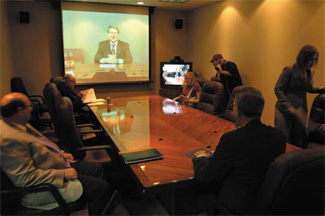The University of Texas at Arlington wants to be the area’s leading research university. UT Dallas does, too.
But instead of dividing the resources that each needs to get there, top administrators at both schools say they’ll work together to attract research grants, exceptional faculty and scholarly students.
 |
| UT Dallas President David Daniel (on screen) and UT Arlington President James D. Spaniolo (sitting at head of table) use a Swap Day teleconference to announce 10 areas of collaboration. |
UT Arlington President James D. Spaniolo and David Daniel, his counterpart at UTD, call it a win for the universities, The University of Texas System and all of North Texas. Dallas/Fort Worth is the nation’s largest area without a prominent research university, often called a “flagship.”
“We’re going to capitalize on each other’s strengths (because) this region has not gotten its share of higher education appropriations,” Dr. Daniel said. “President Spaniolo and I both understand that the best way for UTD and UT Arlington to achieve their full potential is by working together.”
In Texas, only UT Austin and Texas A&M are considered flagship institutions. Some educational leaders insist that this puts Texas behind states like California, Florida, Massachusetts and New York in research dollars, patents and technology transfer and in luring the best scientists and entrepreneurs.
“UT Arlington and UT Dallas both need to succeed, and the best way for them to do that is by collaborating,” Spaniolo said. “We believe we will be able to accomplish much more this way than we would by going it alone.”
To illustrate their willingness to work together, Spaniolo and Daniel swapped roles for a day last fall. The event put each president symbolically at the helm of the other’s university and included meetings with student leaders, faculty members and administrators.
It was a short drive. UT Arlington and UTD are only 35 miles apart. Both have nationally recognized colleges of engineering and science, both are considered emerging institutions, and both feature numerous distinguished faculty researchers.
There are also key differences. UT Arlington is a comprehensive university, while UTD is more narrowly focused and specifically defined. UT Arlington’s enrollment is also twice as large.
|
10-Point
Plan
|
The notion that collaboration allows one university to contribute resources the other may lack sparked a 2002 swap between the presidents of longtime rivals Texas A&M and UT Austin—a stunt that ultimately resulted in more publicity than promise.
Daniel said this won’t happen with UT Arlington and UTD. “We will follow up,” he said, “to make sure that the ideas do come to fruition.”
In fact, the two presidents used a Swap Day teleconference to announce 10 specific areas of collaboration. Already, UT Arlington and UTD partner on projects in science- and technology-based fields like nanotechnology, brain imaging, robotics, computer science and electrical engineering.
They’re collaborators in the UT TeleCampus program. They plan to submit a joint grant application to study pain levels in sickle cell patients. Both universities work with The University of Texas Southwestern Medical Center at Dallas on projects, including an advanced medical imaging center that opens in the spring.
“This is not a beginning, and it’s not just the continuation of the status quo,” Spaniolo said. “This is a new era of heightened respect and cooperation for both schools. It is important for the future of both universities and an absolute necessity for the economic growth of the North Texas region and the entire state.”
Daniel: “Is Harvard any worse off because MIT is literally right across the street? No. Is Berkeley any worse off because of Stanford? No; they both work together to benefit the Bay Area. The world of research is changing to focus on areas of collaboration.”
Daniel called this focus “particularly important and significant, not only to the community at our respective universities but the community at large in the Dallas/Fort Worth Metroplex.”
Spaniolo takes it a step further.
“We have a great responsibility to students, taxpayers and the entire region
to leverage our capabilities and to work together,” he said. “We’re looking for
real ways to provide value to each other and to our students, faculty and staff
as well as, of course, the citizens of Texas.”
— Danny Woodward
| Archives
| Alumni Association |
Giving to UTA | UTA
Home Copyright © 2006 UTA Magazine. All rights reserved. |
